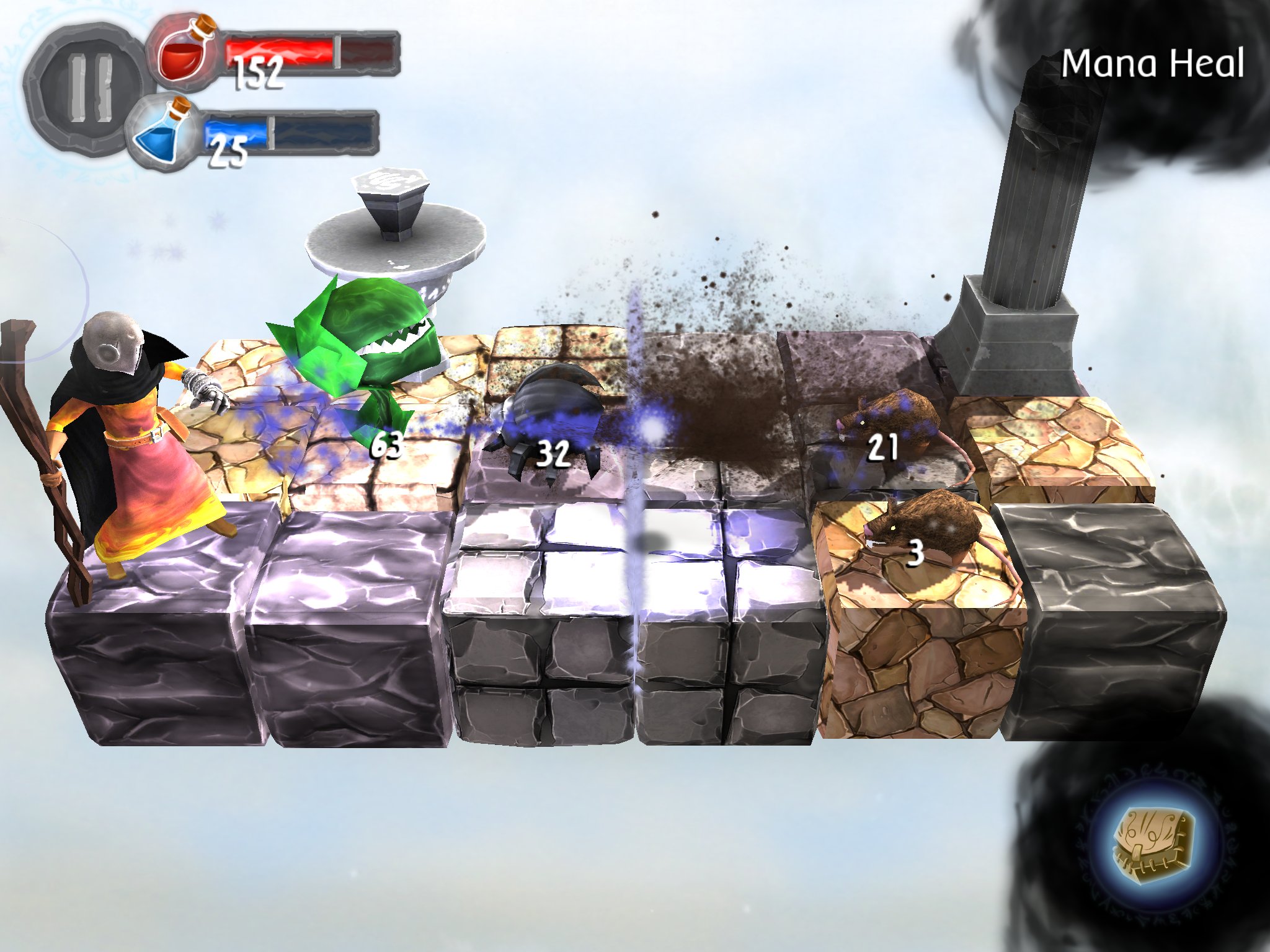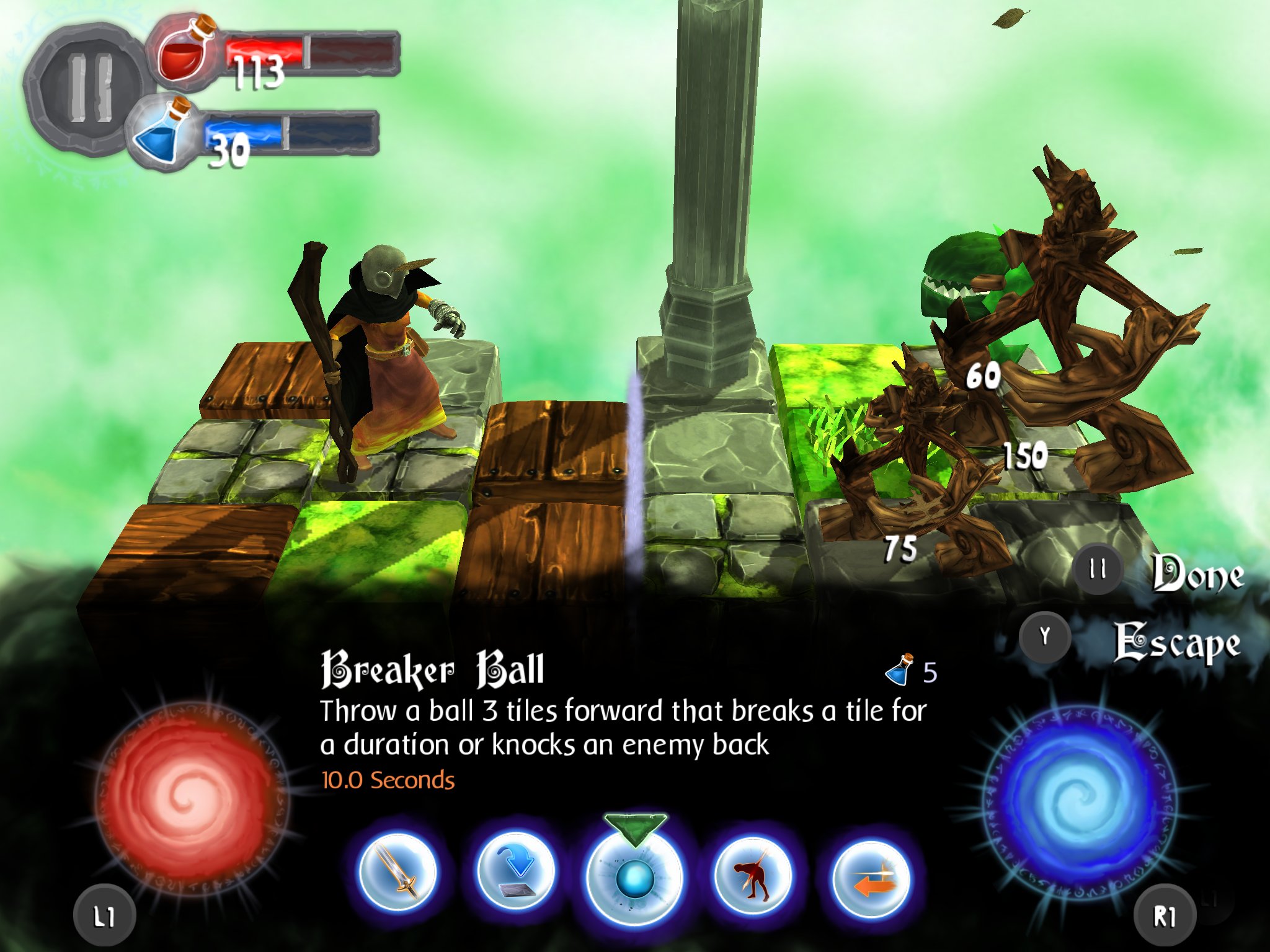I wanted to love Phantom Rift ($0.99). I wanted to give it my unabashed affection. I am quite fond of the Mega Man Battle Network series because of, well, everything about it. Certainly, paying homage to Mega Man is something Phantom Rift isn’t doing, but the series itself is paying homage to boasted a unique combat system that took the best aspects of card games and mixed it with fast-paced real-time combat. But where Phantom Rift falls apart is not respecting that speed. Not so much in the combat, but in the overworld that governs getting from fight to fight, and managing the character and deck: it’s just too slow to get anywhere in this game, both figuratively and literally.
The combat takes place on a 6-by-3 grid, with you controlling your custom character on the left side, and the enemies on the right side. You have a pool of mana that recharges over time, and every so often, you draw from 5 spells, coming from a deck of 30 spells. These spells cost mana to equip, and are single-use abilities, that can attack enemies, heal, put up plants that can protect you and hit enemies, and more.
In battle, you move from square to square, dodging attacks, and trying to time the right moment to use those spells to do the most damage. There’s nothing more satisfying than using a spell to pull an enemy within range of your long sword spell to take them out right as the battle starts – and winning quickly nets you more spirit orbs, which can be used in the overworld to heal, reveal a level map, or to buy new items. Doing all this against bosses? Even better.
Spells are earned by defeating enemies, collecting them in chests, or buying packs – either in-game or through IAP. The game can definitely be played without additional purchases beyond the $2.99 price, but the IAP packs just make it possible to get more powerful spells early on. And hey, having an awesome deck that fits your fighting style is quite pleasing. Building a deck of spells to unleash with proper timing in combat feels so much better than building a deck of cards, I say.
Everything that relates to combat in Phantom Rift is a joy to play. The combat is always so dynamic, based on the decks and the enemies that pop up. This is how randomness should be used in a game – it winds up being a test of the player’s skill to adapt to the luck of the draw at any given time, and to form strategies, one spell draw at a time.
The controls use swipes to move around, taps to fire the basic weapon, which doesn’t do much damage, mostly just to chip away at enemies when there’s no spells to use, and then tapping on the spell icons to use them. iPad players might want to go into the options and move the spells to the left or right side, they work a lot better for quick activation in combat. If you have an MFi controller, Phantom Rift supports it and feels like the best way to play this game, though touch controls are absolutely fine.
But oh how the non-battle portions of Phantom Rift annoy me. The problem is that they’re all so slow. The game takes place in different elemental overworlds with individual multi-level worlds to go into, that are randomly generated each time. Essentially, you don’t know what to exepct when walking through a world, though the overworlds are fixed.
The problem starts with walk speeds. The protagonist moves at a crawl through the world. As such, the random encounters wind up feeling like they happen more often than they should, making fun battles feel more like a hindrance than the entertainment that they should be. The worlds generally feel like they’re a few levels too long, and it’s annoying to get to the end of a world, find out that you’re just too weak to succeed without blowing through all your orbs to revive (and not being able to revive right at the boss at the end of a world is unacceptable), and have to go back and grind to get more and better spells, or find better items, or buy better items, or whatever needs to be done.
I feel like this game is permanently going at half the speed it needs to go at. I have no real qualms with the combat speed as is, but if it were faster I wouldn’t complain either. Certainly, there’s a lot of game to play here, but part of that is because it takes so long to do anything! Even just being able to run around in the levels would help a lot! All this slowness also makes character progression and deck building feel so tedious that any change is incremental at best.
Also, the whole aesthetic of the game feels less less stylistically ethereal, and more bland and soulless. The worlds feel way too empty and repetitive. The darkness of the overworld just makes it hard to see rather than providing any feel of forboding. The Bastion ($4.99) style of having blocks pop in feels more like an excuse for poor draw distances than a cool stylistic effect. Also, having blocks that touch diagonally not be able to be traveled across? Just annoying, and I don’t know why they exist because they just make walking anywhere a lot harder.
It’s just sad, really. I love Phantom Rift sometimes. I love it when I unleash back-to-back spells that wipe out my enemies. I love it when I’m customizing my deck.I love it when I feel like I’m actually getting somewhere in the game. The problem is that those moments of love are so fleeting because getting from battle to battle is so tedious, and it weakens the fun parts of fighting and deck building. Perhaps those with a lot of patience will absolutely love Phantom Rift, and maybe I’m just more impatient than the teenager I was when I fell in love with this style of play in the MMBN games. But Phantom Rift could just be so, so, much better, even if what it does well it does really, really well.




